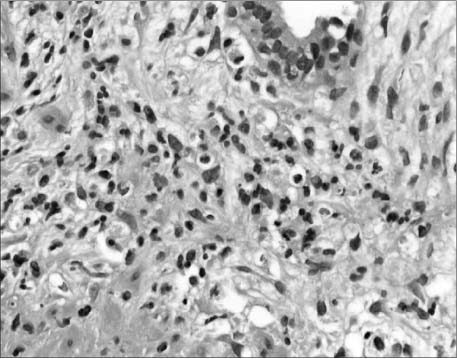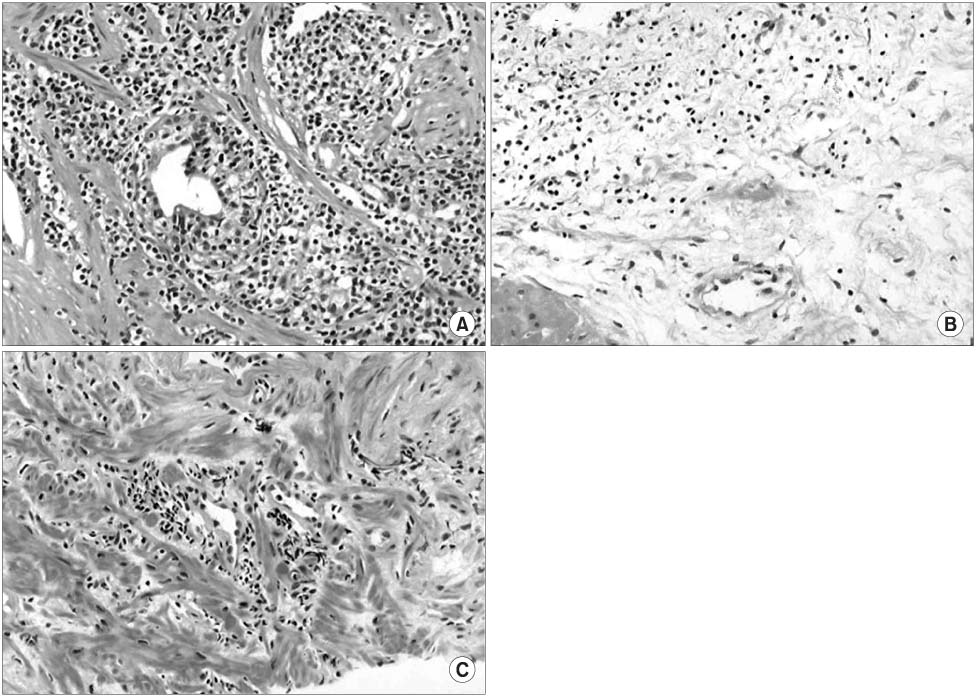Korean J Urol.
2006 Jan;47(1):31-36. 10.4111/kju.2006.47.1.31.
Elevation of Serum Prostate Specific Antigen in Subclinical Prostatitis: The Role of Pathology of Inflammation
- Affiliations
-
- 1Department of Urology, Inje University College of Medicine, Gimhae, Korea. ircho@ilsanpaik.ac.kr
- 2Department of Pathology, Inje University College of Medicine, Gimhae, Korea.
- KMID: 2294212
- DOI: http://doi.org/10.4111/kju.2006.47.1.31
Abstract
-
PURPOSE: We evaluated the correlation of the pathologic diagnosis, including the grade or location of the inflammation on a prostate biopsy specimen, to the serum prostate-specific antigen(PSA) level.
MATERIALS AND METHODS
172 patients(the patients' PSA was> or=4ng/ml) who received prostate biopsy at our department from January 2000 to August 2003 were retrospectively studied. The pre-biopsy PSA and pathology, including the diagnoses and inflammatory patterns, were analyzed. The pathologic patterns of inflammation were divided as acute or chronic by the predominant inflammatory cell type; especially, the chronic inflammation was divided by grade or location, and then this was reviewed by 1 pathologist. Chronic Inflammation was graded as I, II or III according to the severity of inflammation. The PSA levels were compared among the grades. The presence or absence of chronic inflammation was checked in the periglandular, stromal and perivascular areas, respectively. The PSA levels were compared between the presence and absence of inflammation at each location.
RESULTS
Among 172 patients, the number of patients with prostate cancer was 37(21.5%), and 68 patients had only BPH(39.5%), 27 had only prostatitis(15.7%) and 40 patients had benign prostatic hyperplasia(BPH) with prostatitis(23.3%). The number of patients with any prostatitis was 67(39.0%). The age of the patients was 68.4+/-8.7 years(45-91), the serum PSA was 13.30+/-14.38ng/ml(4.30-102.48), and the prostate size was 49.5+/-21.1ml(20-126). One case of BPH with prostatitis had a PSA level above 100ng/ml. Among the 67 specimens that showed prostatitis, 16 patients had histologically acute inflammation(23.9%) and 51 patients had chronic inflammation(76.1%). The PSA levels of the acute or chronic inflammation patients were 24.04+/-25.95ng/ml(4.46-102.48) and 9.93+/-4.73ng/ml(4.3-21.12, p=0.047), respectively. The PSA levels were not different among the 3 grades of chronic inflammation. In periglandular, stromal and perivascular locations, the PSA levels were not different between the presence and absence of chronic inflammation.
CONCLUSIONS
About 39% of the prostate biopsy specimens showed prostatitis. The PSA level was higher for the acute inflammation than for the chronic inflammation. However, there was no difference in PSA levels among the each of the grades or locations of chronic prostatic inflammation.
Keyword
MeSH Terms
Figure
Cited by 1 articles
-
Clinical Significance of Infected Prostate Tissue in Patients with Benign Prostatic Hyperplasia
Hoon Choi, Seung Chol Park, Hee Jong Jeong, Ji Hyun Jo
Korean J Urol. 2009;50(10):1014-1017. doi: 10.4111/kju.2009.50.10.1014.
Reference
-
1. Stamey TA, Kabalin JN. Prostate specific antigen in the diagnosis and treatment of adenocarcinoma of the prostate. I. Untreated patients. J Urol. 1989. 141:1070–1075.2. Brawer MK, Rennels MA, Nagle RB, Schifman R, Gaines JA. Serum prostate-specific antigen and prostate pathology in men having simple prostatectomy. Am J Clin Pathol. 1989. 92:760–764.3. Irani J, Levillain P, Goujon JM, Bon D, Dore B, Aubert J. Inflammation in benign prostatic hyperplasia: correlation with prostate specific antigen value. J Urol. 1997. 157:1301–1303.4. Hara M, Koyanagi Y, Inoue T, Fukuyama T. Some physicochemical characteristics of "gamma-seminoprotein", an antigenic component specific for human seminal plasma. Nippon Hoigaku Zasshi. 1971. 25:322–324.5. Wang MC, Valenzuela LA, Murphy GP, Chu TM. Purification of human prostate specific antigen. Invest Urol. 1979. 17:159–163.6. Papsidero LD, Wang MC, Valenzuela LA, Murphy GP, Chu TM. A prostate antigen in sera of prostatic cancer patients. Cancer Res. 1980. 40:2428–2432.7. Lilja H. Structure, function, and regulation of the enzyme activity of prostate-specific antigen. World J Urol. 1993. 11:188–191.8. Diamandis EP, Yu H. Nonprostatic sources of prostate-specific antigen. Urol Clin North Am. 1997. 24:275–282.9. Oesterling JE. Prostate specific antigen: a critical assessment of the most useful tumor marker for adenocarcinoma of the prostate. J Urol. 1991. 145:907–923.10. Stamey TA, Yang N, Hay AR, McNeal JE, Freiha FS, Redwine E. Prostate-specific antigen as a serum marker for adenocarcinoma of the prostate. N Engl J Med. 1987. 317:909–916.11. Dalton DL. Elevated serum prostate-specific antigen due to acute bacterial prostatitis. Urology. 1989. 33:465.12. Neal DE Jr, Clejan S, Serma D, Moon TD. Prostate-specific antigen and prostatitis I, Effect of prostatitis on serum PSA in the human and nonhuman primate. Prostate. 1992. 20:105–111.13. Nadler RB, Hymphrey PA, Smith DS, Catalona WJ, Ratiff TL. Effect of inflammation and benign prostatic hyperplasia on elevated serum prostate specific antigen levels. J Urol. 1995. 154:407–413.14. Pansadoro V, Emiliozzi P, Defidio L, Scarpone P, Sabatini G, Brisciani A, et al. Prostate-specific antigen and prostatitis in men under fifty. Eur Urol. 1996. 30:24–27.15. Cho IR, Kim GJ, Park SS, Choi HS. PSA and prostatitis in men under 45 years old. Korean J Urol. 1998. 39:633–637.16. Cho IR, Chang YS, Roh JS, Jeon JS, Park SS. Change of PSA and PSAD after antibiotic treatment in patients with prostatitis. Korean J Androl. 2002. 20:100–105.17. Lee SY, Park YY. Clinical characteristics of the associated histopathological findings in benign prostatic hyperplasia. Korean J Urol. 1991. 32:915–920.18. Yamamoto M, Hibi H, Miyake K. Prostate-specific antigen levels in acute and chronic bacterial prostatitis. Hinyokika Kiyo. 1993. 39:445–449.19. Kohnen PW, Drach GW. Patterns of inflammation in benign prostatic hyperplasia: a histologic and bacteriologic study. J Urol. 1979. 121:755–760.20. Hasui Y, Marutsuka K, Asada Y, Ide H, Nishi S, Osada Y. Relationship between serum prostate specific antigen and histological prostatitis in patients with benign prostatic hyperplasia. Prostate. 1994. 25:91–96.21. Kessaris DN, Lee CK, Valderamma E, Moldwin RM. Prostatic specific antigen immunohistochemistry in patients with prostatitis. J Urol. 1994. 151:Suppl. 404. abstract 707.22. Schatteman PH, Hoekx L, Wyndaele JJ, Jeuris W, Van Marck E. Inflammation in prostate biopsies of men without prostatic malignancy or clinical prostatitis: correlation with total serum PSA and PSA density. Eur Urol. 2000. 37:404–412.23. Platz EA, De Marzo AM. Epidemiology of inflammation and prostate cancer. J Urol. 2004. 171:Suppl. 36–40.
- Full Text Links
- Actions
-
Cited
- CITED
-
- Close
- Share
- Similar articles
-
- Effect of Asymptomatic Prostatitis in Prostate Needle Biopsies on the Serum Prostate Specific Antigen and Prostate Specific Antigen Density
- Effects of Benign Prostatic Diseases on the Level of Serum Prostate Specific Antigen
- Asymptomatic Prostatitis: Clinical Significances and Management
- The Value of Serum Prostate-specific Antigen in the Diagnosis and Follow-up of Acute Prostatitis
- Effect of Histological Inflammation on Total and Free Serum Prostate-Specific Antigen Values in Patients Without Clinically Detectable Prostate Cancer




